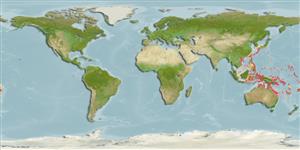Common names from other countries
>
Gobiiformes (Gobies) >
Gobiidae (Gobies) > Gobiinae
Etymology: Fusigobius: Latin, fusus = spindle + Latin, gobius = gudgeon (Ref. 45335); gracilis: Named for its being the most slender among its congeners..
More on author: Randall.
Environment: milieu / climate zone / depth range / distribution range
Ecologia
marino demersale; distribuzione batimetrica 6 - 18 m (Ref. 41649). Subtropical
Distribuzione
Stati | Aree FAO | Ecosystems | Presenze | Point map | Introduzioni | Faunafri
Western Pacific: Ryukyu Islands to the Great Barrier Reef and New Caledonia, east to Fiji.
Size / Peso / Age
Maturity: Lm ? range ? - ? cm
Max length : 4.2 cm SL maschio/sesso non determinato; (Ref. 41649); 3.0 cm SL (female)
Short description
Chiavi di identificazione | Morfologia | Morfometria
Spine dorsali (totale) : 7; Raggi dorsali molli (totale) : 9; Spine anali: 1; Raggi anali molli: 8; Vertebre: 26. Diagnosis: Dorsal rays VI - I,9. Anal rays 1,8. Pectoral rays 17-19 (usually 18). Longitudinal scale series 25. Head naked except for scales on side of nape reaching nearly to above upper end of preopercular margin; posterior nostril not close to orbit. The body is slender, depth 5.45-5.75 in SL; snout length 3.0-3.4 in head; first dorsal fin not higher than second; second dorsal spine usually longest, 5.35-5.8 in SL. Pelvic fins fully joined medially by membrane (when intact); pelvic frenum absent. Body translucent with numerous very small orange-yellow spots with blackish centers on head and body, those on head arranged in oblique rows; a black spot the size of pupil or smaller at midbase of caudal fin; a second smaller blackish spot just above base of pectoral fin; dorsal and caudal fins with orange-yellow spots; a dusky orange line from upper part of first membrane of first dorsal fin to base of second spine (Ref. 41649).
Inhabits sand-rubble bottoms next to reefs in 6-18 m (Ref. 90102).
Life cycle and mating behavior
Maturities | Riproduzione | Spawnings | Egg(s) | Fecundities | Larve
Randall, J.E., 2001. Five new Indo-Pacific gobiid fishes of the genus Coryphopterus. Zool. Stud. 40(3):206-225. (Ref. 41649)
IUCN Red List Status (Ref. 130435)
Can't connect to MySQL database (fbapp). Errorcode: Too many connections
